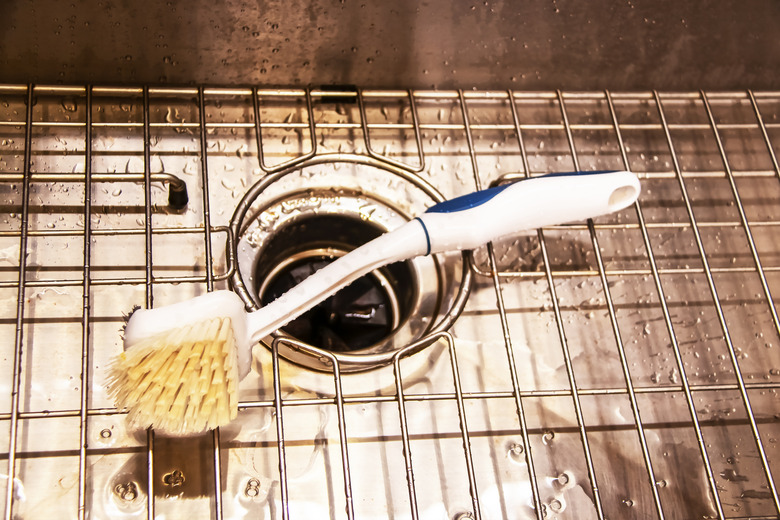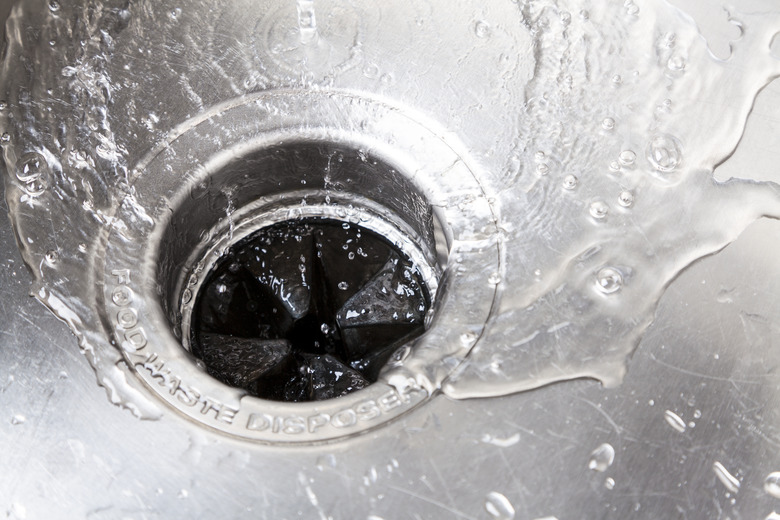How To Get Your Garbage Disposal Seriously Clean In 5 Easy Steps
We may receive a commission on purchases made from links.
The greenest way to get rid of food waste is to compost it and use the compost in your garden, but this can be impractical for those who don't have time or space to create a compost pile. A garbage disposal is a convenient and safe alternative for homes on municipal waste systems — but when it hasn't been properly used (or it's been awhile since it's had some TLC), it can be quite smelly, to put it plainly.
The good news is that a garbage disposal is fairly easy to clean. The bad news is that neglected garbage disposals — and garbage disposal drains — can and do clog, and when they do, there are some things you definitely shouldn't try to fix it.
If you understand how a garbage disposal works, you'll have a better idea of what DIY maintenance involves. Here's a hint: It doesn't work like a blender.
Get to Know Your Garbage Disposal
Get to Know Your Garbage Disposal
If you look into the mouth of your garbage disposal while the power is off, you'll see what look like blades in the bottom of the canister, and that's what gives the impression of a blender. In reality, these are impellers. They aren't sharp, and they don't macerate. They fling food toward the sides of the canister, which are lined by a shredder ring, and this is where the actual pulverization happens.
The shredder ring is like a curved cheese grater, and it works in somewhat the same way. The force of the impellers keep the food scraps scraping repeatedly against the ring, and the scraps turn into tiny, partially liquefied particles that flush away in the steady stream of water that should be running whenever the garbage disposal is turned on.
Just as cheese eventually clogs a cheese grater, starchy and greasy food scraps eventually clog the shredder ring. On top of that, some of the food scraps collect around the rim of the disposer and underneath the rubber splash guard, and they stay there (and smell bad) until you clean them off. To keep your disposal unit clean, you have to get rid of buildup on the shredder ring, the underside of the splash guard, and the rim of the disposal unit.
Things Needed
-
Ice cubes
-
Citrus fruit
-
Toothbrush
How to Clean a Garbage Disposal
How to Clean a Garbage Disposal
Warning
You've seen what your garbage disposal can do to leftovers, and if you don't want that to happen to your fingers, you need to work safely. Never reach your fingers deeper than necessary to clean the rim. Even if you've disabled the disposal, the shredder ring is sharp enough to cut you.
1. Turn Off the Power
Unplug the garbage disposal. If your unit is hardwired, locate the breaker in the main panel and turn it off. Don't rely on simply turning off the switch because even though it seems unlikely, you or someone else could inadvertently turn it on while you're working, and whatever cleaning supplies you're using — or the garbage disposal itself — could be ruined.
2. Clean the Splash Guard
If your splash guard (aka the flappy drain cover) is removable, as most are, take it out and scrub the underside with dish soap, water, and an old toothbrush. Add a little baking soda to the cleaning mixture for deodorizing. Splash guards are dishwasher-safe, so if you want to get yours really clean, put it in the dishwasher with the rest of the dishes.
If the splash guard isn't removable, put a few drops of dish soap on a wet kitchen scrubber, add a few sprinkles of baking soda, reach through, and clean the rubber from underneath. Then, rinse the scruber with clean water and use it to wash off the soap.
3. Clean Around the Rim
While the splash guard is off, clean around the rim with a wet scrubber, dish soap, and baking soda. Use the toothbrush to clean around the underside to remove any food particles that may be lodged there. If the splash guard isn't removable, just make sure you clean the rim while you're cleaning the splash guard.
4. Clean the Shredder Ring
The use of ice cubes for cleaning a garbage disposal is controversial, but when used properly, they can help effectively dislodge buildup on the shredder ring. Instead of simply grinding them straight through the disposer, which won't do much of anything, try the following:
- Layer 1 or 2 cups of ice cubes or crushed ice and about a cup of rock salt until the canister is full. The salt lowers the melting temperature of the ice, essentially making it colder and hardening all the starches, grease, and other gunk on the shredder ring.
- Let the ice/salt mixture sit in the canister for about 20 minutes but don't let it melt completely.
- Turn on the cold water and the disposer and let it grind all the ice. As the ice and salt pass through the shredder, they will take all the hardened gunk with them.
5. Deodorize the Canister
You can use one of several cleaning methods to neutralize bad odors in a garbage disposal:
- Cut several citrus fruits into slices and grind them up while you run cold water. Citrus peels have deodorizing properties, and they will help scrub grime off the shredder ring.
- Sprinkle about 1/2 cup of baking soda into the canister and follow this with a cup of white vinegar. The mixture will create a cleansing foam that should back up and fill the bottom of the sink. Let it work for a few minutes before turning on the water and flushing it down.
- Close the sink stopper and fill the kitchen sink about halfway with very hot water. Add a big squirt of dish soap, mix it in, and then remove the stopper and run the disposal while the water drains.
Garbage Disposal Cleaning Don'ts
Garbage Disposal Cleaning Don'ts
- Don't reach in your fingers past the rim. If you need to extract something, do it with pliers or tongs.
- Don't use drain cleaner. It can splash from the opening and give you skin burns, and it can damage the disposal. If there's a clog in the pipes, disassemble the P-trap to remove it.
- Don't use bleach to disinfect. It's corrosive and can damage the disposal and the drainpipes.
- Don't try to clean the shredder ring with hot water. It will turn the starches and grease to goo and make a bad situation worse.
- Don't grind eggshells or coffee grounds to clean the shredder ring. Eggshells have a sticky membrane that will add to the clog, and coffee grounds get stuck in the grate.
- Don't put greasy foods, like peanuts; starchy foods, like potatoes or pasta; or fibrous vegetables, like celery or corn husks, in the garbage disposal.


